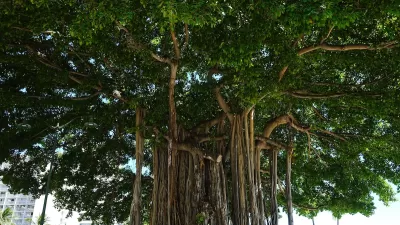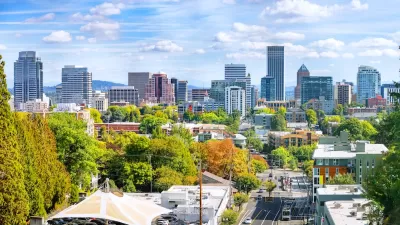A tiny insect, native to Asia, has been killing trees in huge numbers around the United States since 2002. With the emerald ash borer expected to spread, cities are trying to prepare to combat the worst of the devastation.
"An exotic pest that has damaged trees in Boulder is expected to spread to metro Denver and could cost millions of dollars in dead and dying trees," reports Elizabeth Hernandez.
The news about the emerald ash borer, which originates from Asia, comes via a report released by the Colorado State Forest Service. According to the report, " The potential economic impacts of (emerald ash borer) in the metro Denver area alone could be as high as $82 million, based on a loss of annual services provided by the canopy cover, and not including potential costs for ash tree removal, treatment and replacement…"
An earlier report by Susan Clotfelter described the devastating impacts of the emerald ash borer in Boulder back in 2013. Planetizen has noted the emerald ash borer's prominence in a planning story from Louisville and a story from 2002 in Ann Arbor, when the insect was first found in the United States.
The emerald ash borer is also making trouble in Bozeman, Montana, where the city commission recently approved a plan to prepare for the "inevitable arrival of the invasive emerald ash borer…" Eric Dietrich reports these details on the plan in Bozeman:
Among other provisions, it calls for expanding the city’s four-member forestry department, adding the equivalent of three employees to increase pruning frequency, complete an inventory of tree locations and proactively prepare for the ash borer’s arrival. Those actions will require a 26 percent increase to the Bozeman Forestry Division's annual budget. The ash trees targeted by the insects "constitute about 80 percent of Bozeman trees in the downtown area and half the urban forest citywide."
In addition to the high costs incurred by the devastation caused by the emerald ash borer, they are also likely to cause physiological effects on humans as well. A recent study concluded: "Women living in a county infested with the emerald ash borer had a 25 percent increased risk of cardiovascular disease."
FULL STORY: Emerald ash borer could cause $82 million impact in metro Denver, report says

Alabama: Trump Terminates Settlements for Black Communities Harmed By Raw Sewage
Trump deemed the landmark civil rights agreement “illegal DEI and environmental justice policy.”

Planetizen Federal Action Tracker
A weekly monitor of how Trump’s orders and actions are impacting planners and planning in America.

The 120 Year Old Tiny Home Villages That Sheltered San Francisco’s Earthquake Refugees
More than a century ago, San Francisco mobilized to house thousands of residents displaced by the 1906 earthquake. Could their strategy offer a model for the present?

Ken Jennings Launches Transit Web Series
The Jeopardy champ wants you to ride public transit.

BLM To Rescind Public Lands Rule
The change will downgrade conservation, once again putting federal land at risk for mining and other extractive uses.

Indy Neighborhood Group Builds Temporary Multi-Use Path
Community members, aided in part by funding from the city, repurposed a vehicle lane to create a protected bike and pedestrian path for the summer season.
Urban Design for Planners 1: Software Tools
This six-course series explores essential urban design concepts using open source software and equips planners with the tools they need to participate fully in the urban design process.
Planning for Universal Design
Learn the tools for implementing Universal Design in planning regulations.
Clanton & Associates, Inc.
Jessamine County Fiscal Court
Institute for Housing and Urban Development Studies (IHS)
City of Grandview
Harvard GSD Executive Education
Toledo-Lucas County Plan Commissions
Salt Lake City
NYU Wagner Graduate School of Public Service




























